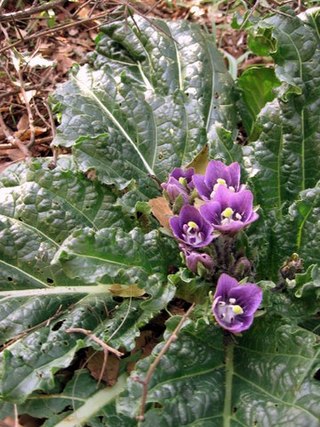A homunculus is a small human being. Popularized in sixteenth-century alchemy and nineteenth-century fiction, it has historically referred to the creation of a miniature, fully formed human. The concept has roots in preformationism as well as earlier folklore and alchemic traditions.
The Masque of Mandragora is the first serial of the 14th season of the British science fiction television series Doctor Who, which was first broadcast in four weekly parts on BBC1 from 4 to 25 September 1976.

Sword of the Berserk: Guts' Rage, released in Japan as Berserk Millennium Falcon Arc: Chapter of the Flowers of Oblivion, is a hack and slash action video game for the Dreamcast. It is based on the popular Berserk manga by Kentarō Miura and the game is set between volume 22 and 23 of the manga; right after Guts and Puck depart for Elfhelm with Casca, but before Farnese, Serpico, and Isidro catch up with them. The music is composed by Susumu Hirasawa, who also composed the anime series' music.

Robert James was a Scottish actor, who was best known for his television work.

The Eleventh Tiger is a BBC Books original novel written by David A. McIntee and based on the long-running British science fiction television series Doctor Who. It features the First Doctor, Ian, Barbara, and Vicki.

Mandragora officinarum is the type species of the plant genus Mandragora in the nightshade family Solanaceae. It is often known as mandrake, although this name is also used for other plants. As of 2015, sources differed significantly in the species they use for Mandragora plants native to the Mediterranean region. The main species found around the Mediterranean is called Mandragora autumnalis, the autumn mandrake. In a broader circumscription, all the plants native to the regions around the Mediterranean Sea are placed in M. officinarum, which thus includes M. autumnalis. The names autumn mandrake and Mediterranean mandrake are then used. Whatever the circumscription, Mandragora officinarum is a perennial herbaceous plant with ovate leaves arranged in a rosette, a thick upright root, often branched, and bell-shaped flowers followed by yellow or orange berries.

Winx Club: The Secret of the Lost Kingdom is a 2007 Italian animated fantasy film directed and co-written by Iginio Straffi. It is an adaptation of the animated television series Winx Club, taking place after the events of the first three seasons.

Beautiful Chaos is a BBC Books original novel written by Gary Russell and based on the long running science fiction television series Doctor Who. It features the Tenth Doctor and Donna Noble. It was published on 26 December 2008, alongside The Eyeless and The Story of Martha.
La Mandrágora was a Chilean Surrealist group "officially founded" on 12 July 1938 by Braulio Arenas (1913-1988), Teófilo Cid and Enrique Gómez Correa. The group had met in Talca and first started exchanging in 1932. They published an eponymous review and an anthology of poetry, El A, G, C de la Mandrágora, which included works by all founders except Teófilo Cid. Politically, the group supported the Popular Front.

The squasc is a mythological being of the Eastern Lombardy region folklore.
Sacred herbs are herbs that are considered sacred in some religions. Herbs such as myrrh, ague root, and frankincense in Christianity, Nine Herbs Charm in the partially Christianized Anglo-Saxon pagan, and a form of basil called tulsi—revered as a Hindu goddess for its medicinal value—are utilized in their rites and rituals.
Wiktor Grodecki is a Polish film director, screenwriter and producer known for Mandragora as well as Insatiability - an adaptation of the eponymous novel by Stanisław Ignacy Witkiewicz - which was awarded Best Indie Director prize by SAG in USA in 2004.

The fourteenth season of British science fiction television series Doctor Who began on 4 September 1976 with The Masque of Mandragora, and ended with The Talons of Weng-Chiang. The third Fourth Doctor series, it was the final series of Philip Hinchcliffe's production, whilst Robert Holmes stayed till The Sun Makers in the next series.

Rolando Mandragora is an Italian professional footballer who plays as a defensive midfielder for Serie A club Fiorentina.

Mandragora is a plant genus belonging to the nightshade family (Solanaceae). Members of the genus are known as mandrakes. Between three and five species are placed in the genus. The one or two species found around the Mediterranean constitute the mandrake of ancient writers such as Dioscorides. Two or three further species are found eastwards into China. All are perennial herbaceous plants, with large tap roots and leaves in the form of a rosette. Individual flowers are bell-shaped, whitish through to violet, and followed by yellow or orange berries.

A mandrake is the root of a plant, historically derived either from plants of the genus Mandragora found in the Mediterranean region, or from other species, such as Bryonia alba or the American mandrake which have similar properties. The plants from which the root is obtained are also called "mandrakes". Mediterranean mandrakes are perennial herbaceous plants with ovate leaves arranged in a rosette, a thick upright root, often branched, and bell-shaped flowers that produce yellow or orange berries. They have been placed in different species by different authors. They are highly variable perennial herbaceous plants with long thick roots and almost no stem. The leaves are borne in a basal rosette, and are variable in size and shape, with a maximum length of 45 cm (18 in). They are usually either elliptical in shape or wider towards the end (obovate), with varying degrees of hairiness.

Mandragora autumnalis, known as mandrake or autumn mandrake, is recognized by some sources as a separate species from Mandragora officinarum, although with different circumscriptions. Others regard it as merely part of this very variable species. Plants given the name Mandragora autumnalis consist of a rosette of leaves up to 60 cm (2 ft) across, close to the ground, with a central group of usually purplish flowers followed by yellow or orange berries. The large tap-roots as well as the leaves contain alkaloids and are toxic. They have traditional uses as herbal medicines.
Mandragora turcomanica, the Turkmenian mandrake, is a perennial herbaceous plant in the family Solanaceae, native to the Köpet Dag mountains in Turkmenistan and one location in neighbouring Iran. It differs from the mandrakes found around the Mediterranean chiefly by being larger.










